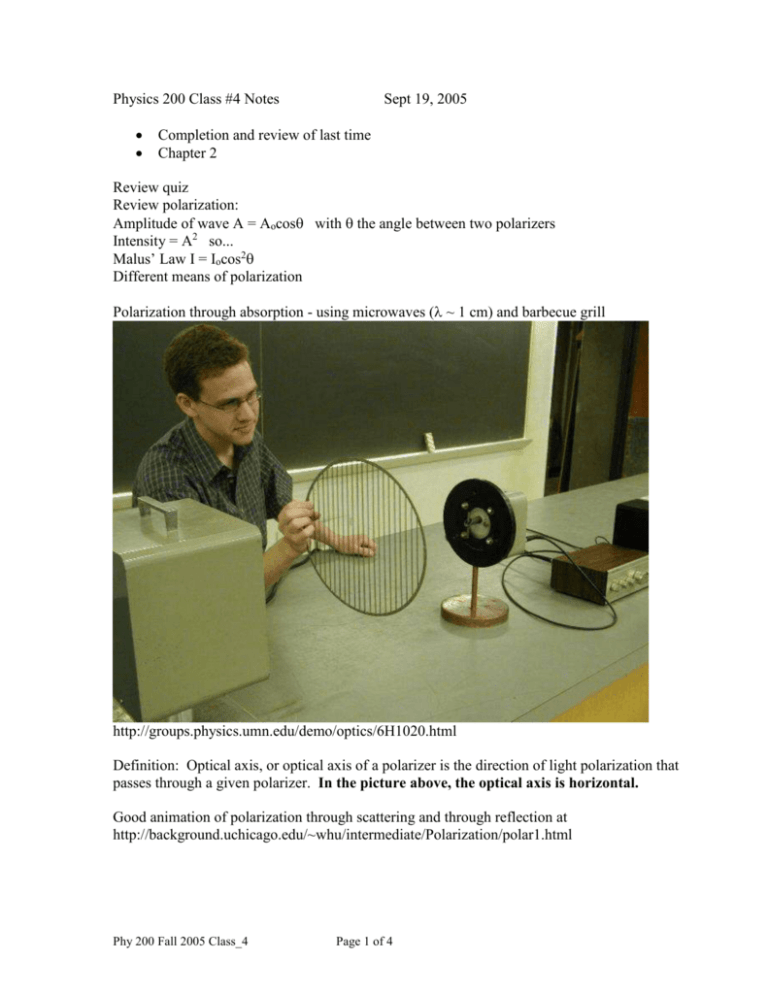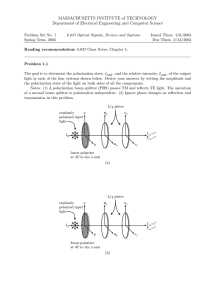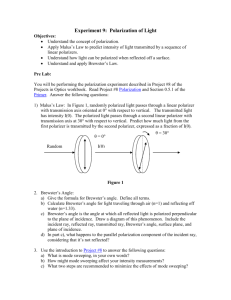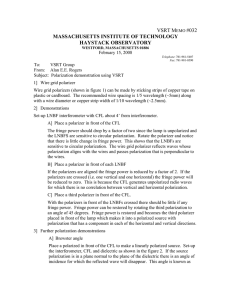Lecture 4, Sept. 19
advertisement

Physics 200 Class #4 Notes Sept 19, 2005 Completion and review of last time Chapter 2 Review quiz Review polarization: Amplitude of wave A = Aocos with the angle between two polarizers Intensity = A2 so... Malus’ Law I = Iocos2 Different means of polarization Polarization through absorption - using microwaves ( ~ 1 cm) and barbecue grill http://groups.physics.umn.edu/demo/optics/6H1020.html Definition: Optical axis, or optical axis of a polarizer is the direction of light polarization that passes through a given polarizer. In the picture above, the optical axis is horizontal. Good animation of polarization through scattering and through reflection at http://background.uchicago.edu/~whu/intermediate/Polarization/polar1.html Phy 200 Fall 2005 Class_4 Page 1 of 4 polarization through reflection from http://www.giangrandi.ch/optics/polarizer/polarizer.shtml In this case the light is reflecting off of a horizontal surface. With whatever random polarizations the incident light has (top left) a) the reflected light (top right) will have more horizontally polarized light (in the same plane as the surface) than vertically polarized light, and b) the transmitted (refracted) light (center) will have less horizontally polarized light. The reflected light will be completely polarized in the same plane as the surface it reflects off of (horizontal polarization in this case) when the angle between the reflected and refracted light is 90 degrees. The angle of the incident light when this happens is called Brewster's angle. (Remember, this is also the angle of the reflected light.) To find Brewster's angle: Remember incident = reflected and (look at the figure below) the right side of the dashed line is 180 degrees, which is reflected transmitted + 90o = 180o so reflected transmitted = 90o which is transmitted = 90o reflected = 90o incident remember ni sini = nt sint ni sini = nt sin(90o - i) = nt cosi sini /cos i = tani = nt / ni where i = Brewster's angle Phy 200 Fall 2005 Class_4 Page 2 of 4 Reflection For polarization through scattering remember two things: 1 When the light is moving to the right the wave moves up and down. Just draw a sine wave. It's a transverse wave, so the amplitude is up and down. That is, the amplitude (polarization direction) is perpendicular to the direction the wave is moving. 2 Light is mostly scattered in the plane perpendicular to the polarization direction. If the light that comes in is polarized up and down, the light that is scattered back out does not go up or down, it goes to the side. Any side. Just not up or down. See the light that's coming towards you (bottom left) in the diagram below. If the light that comes in is polarized left and right, the light that scatters out can go up and down or forward or backward, but not left or right. See the light that's going straight up in the diagram. If the light is polarized in the vertical direction, it can scatter horizontally. In math talk, if the incoming light is polarized in the z direction, the light can scatter in the xy plane. If it is polarized in the x direction, it can scatter in the yz plane. etc. Scattering Phy 200 Fall 2005 Class_4 Page 3 of 4 from http://www.giangrandi.ch/optics/polarizer/polarizer.shtml Phy 200 Fall 2005 Class_4 Page 4 of 4











